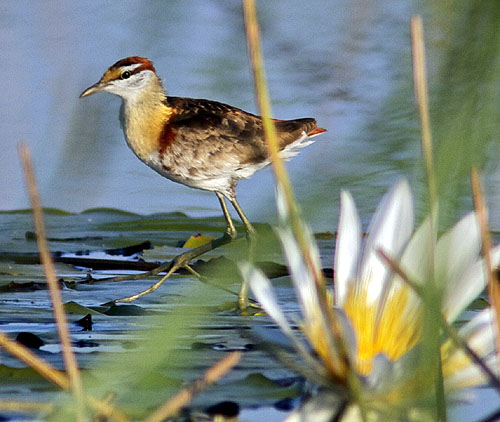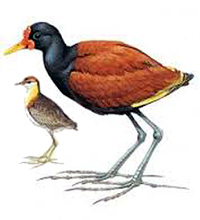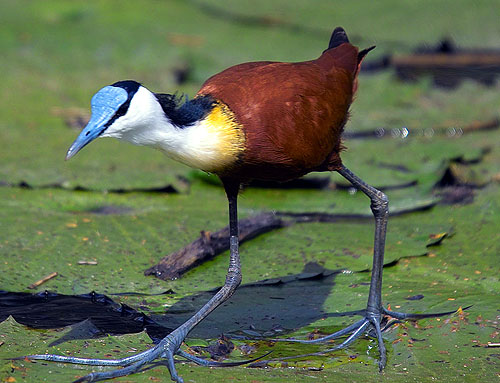 Sometimes nature befuddles me: Why on earth is there a lesser jacana?
Sometimes nature befuddles me: Why on earth is there a lesser jacana?
One of the wondrous moments that a mature birder experiences is when suddenly the puzzle which has been scattered in a hundred million pieces starts to come together.
The prothonotary nests in tree holes not used by the pileated because they’re in swamps where grubs and ants don’t live… The warblers come through in the millions just as insects emerge from winter death… Catbirds which fly so quickly and expertly spend most of their lives in deep bushes because only there can ventriloguy mitigate their placement.
And even without a nice database to organize all this, suddenly pieces upon pieces start to fall into a puzzled but clear image of nature.

There are many “lesser” and “greater” things in the animal kingdom: lesser and greater perch, lesser and greater kudu, and host of lesser and greater birds, but in all but a handful of cases the lesser is very similar to the greater in everything: in niche use, food sources, habitat, breeding and parenting. It’s just … well, they’re less. They’re smaller.
So the answer as to why there is a lesser kudu and a greater kudu might not exist. It could simply be that some mutation along the way made a race that was smaller, and this smaller race continued to fill the niche with the greater.
Perhaps the cleavage of the species exists with so little hybridization because the genetic change happened quickly. It’s also likely that lesser and greater work beautifully when the habitat has lessers and greaters: like lesser and greater bushes and bugs and termite holes.
Greater, or simply jacanas, Africa’s lily trotter, are well known, bountiful and beautiful and widespread across the continent. They’re memorable because their feet are so big: they span bigger, actually, that the bird’s body! This allows them to deftly walk on water lilies and other water debris.
They are a perfect adaptation to the deltas, lakes, swamps and slower rivers of Africa and you can see them practically everywhere as I have for 40 years.
I had the distinct and wondrous pleasure of seeing my first lesser jacana this March in the Okavango Delta. It’s not an endangered species, and it’s not as pretty as the greater jacana but its anatomy is near identical.
There are many fewer lesser in Africa than greater jacana. South African bird specialists call the lesser “near threatened” although the ultimate authority of endangered species, the “IUCN redlist” declines to do so because there is so little data on the birds.
Conforming to the regularity of lesser and greater species, it lives in the same areas, it eats the same things (but maybe smaller ones), it lays the same number of eggs (usually 3) and has very similar alarm and mating behaviors.
They both even share one of the most amazing survival behaviors once eggs have been laid in the nest: If harassed, the parent will float the eggs into the water and nudge them with its beak to a new a presumed safer place!
But then… when it comes to incubating the eggs and raising the young, the two species differ.
The greater’s nesting, incubation and rearing of young is strictly by the female, which is the opposite of the majority of birds in the world in which at least the nurturing process (feeding of young) is shared by both parents. But as with many mammals, the male greater jacana disappears after eggs are laid.
But not with the lesser. More like the majority of birds in the world, both sexes share rearing. And as if to point out this striking difference with their bigger cousin, both sexes actually share in the incubation of the eggs!
This is so arcane as to be fascinating. Why on earth, dear little jacana, did your long trek to survival result in both parents incubating the eggs and rearing the young? Why did your greater cousin not need this unique behavior to survive, but you did?
Pure happenstance? I don’t think so. Rearing of young is pivotal to survival. Despite all its other shared characteristics with its larger cousin, the lesser jacana’s world is different enough that two hands are needed for only one that’s needed in the bigger world.
Why? Is the miniature universe more threatening? Are there more little predators and less bigger predators? Are little things weaker relative to their size?
There’s an answer out there, for sure. I just don’t yet know what it is!
